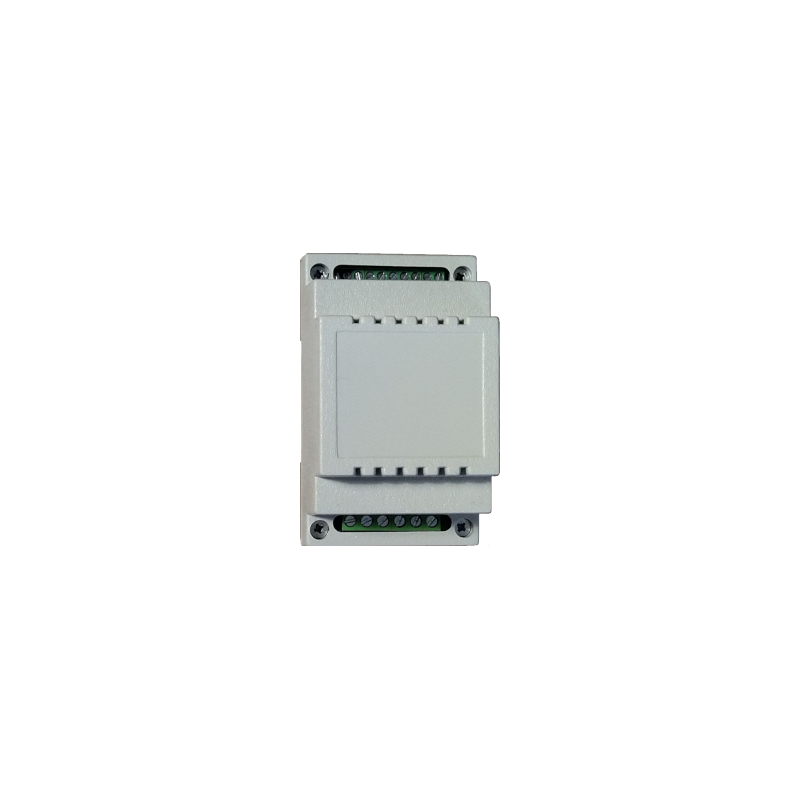

Email: store@creasol.it - Telegram: CreasolTech - Whatsapp: +393283730010
Priority mail: fast and cheap - Express Courier: fast and safe
Before returning products, please contact us

DomBus34 is a DIN-RAIL module, 54mm wide, designed to interface up to 4 power/energy meters, type DDS 238-2 ZN/S (Modbus), to measure power and energy (both imported and exported), voltage frequency and power factor.
It implements 2 relay outputs 250V 5A SPST with overvoltage protection, 1 AC input 110-240Vac, and 2 low-voltage inputs that can be connected to pushbuttons and switches, double pushbuttons and counters.
 Full support: most products are designed by us!
Full support: most products are designed by us!
Email: store@creasol.it - Telegram: CreasolTech - Whatsapp: +393283730010
 Orders are shipped within 1 working day
Orders are shipped within 1 working day
Priority mail: fast and cheap - Express Courier: fast and safe
 24 months warranty, easy return/refund in case of problem
24 months warranty, easy return/refund in case of problem
Before returning products, please contact us
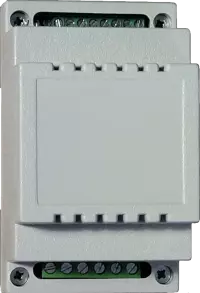 DomBus34 is a DIN-RAIL module, 54mm wide, designed to interface up to 4 power/energy meters, type DDS 238-2 ZN/S (Modbus), to measure power and energy (both imported and exported), voltage frequency and power factor.
DomBus34 is a DIN-RAIL module, 54mm wide, designed to interface up to 4 power/energy meters, type DDS 238-2 ZN/S (Modbus), to measure power and energy (both imported and exported), voltage frequency and power factor.
It implements 2 relay outputs 250V 5A SPST with overvoltage protection, 1 AC input 110-240Vac, and 2 low-voltage inputs that can be connected to pushbuttons and switches, double pushbuttons and counters.
It's designed to activate loads based on power availability, for example when photovoltaic or wind system is producing, and to display nice charts with statistics about energy production/usage with comparisons in a year-by-year basis.
Load switching can be achieved using DCMD commands, but as it works with Domoticz home automation system, it's also easy to make visual and text scripts to do even complex automations.
As other DomBus modules, all ports can be configured in many different ways, and also this module supports DCMD, commands sent to the same or other modules to perform simple actions, that permit to achieve high reliability (DCMD commands work even if domotic controller is not operational) and easy programming (don't need to create automations in the domotic controller, just configure DomBus ports to perform actions on events). Last, but not least, as other DomBus modules, it's optimized to get low power consumption, less than 10mW normally (0.75mA @13.6V) and less than 150mW when all relays are ON (10mA @13.6V).
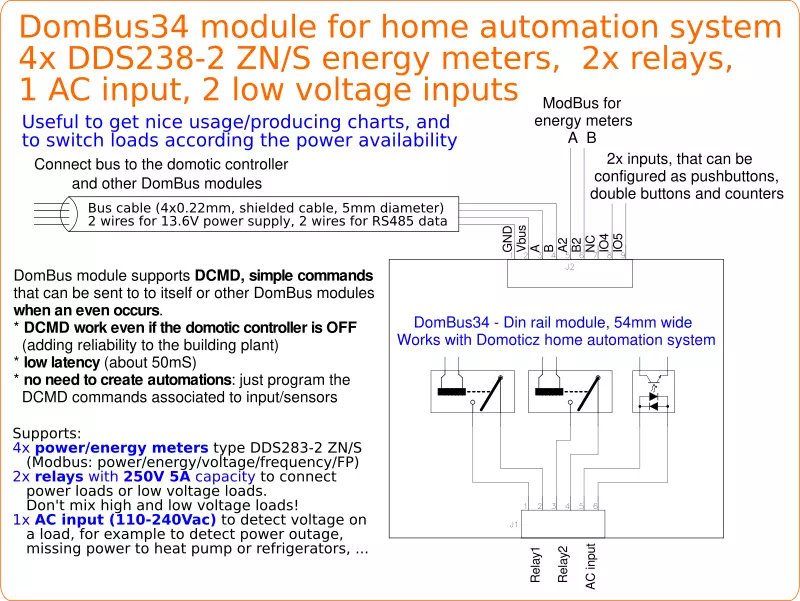
DDS238-2 ZN/S energy meters are factory programmed with Modbus address = 1. Everytime a new energy meter is connected to the Modbus, its default address should be changed as 2, 3, 4 or 5, by selecting the device M1 Addr and writing in the device Description ADDR=2 , for example: in this way the energy meter with Modbus addr=1 will be programmed with the new selected address.
Anytime a new energy meter is added, a new set of device will be enabled, displaying the current import and export power/energy, voltage, power factor and frequency.
*Please check the page in English to get the correct values of commands!
While it's possible to do any automations using the domotic controller features, essential automations can be performed using the DCMD commands that are executed directly by the DomBus module. DCMD commands should be specified in the device description, work even in case that domotic controller is offline and can be sent to the same module itself or to other DomBus modules connected to the same bus.
The syntax is DCMD(Event:ValueLow:ValueHigh)=ModuleAddress.ModulePort:Command:Value
where ValueLow, ValueHigh, Value are optional parameters.
| Event | Description | Example |
| OFF | This even occurs when input (IO1, IO2 or INAC) goes OFF |
DCMD(OFF)=3401.1:OFF When input goes off, turns OFF also port 1 of module 3401 DCMD(OFF)=3102.1:OFF When input goes off, turns OFF also port 1 of module 3102 |
| ON | This even occurs when input (IO1, IO2 or INAC) goes ON |
DCMD(ON)=3401.1:ON:90s When input goes on, turns ON port 1 of module 3401 for 90s DCMD(ON)=3102.1:ON When input goes on, turns ON port 1 of module 3102 |
| PULSE | Input is pulsed ON for less than 0.5s | DCMD(Pulse)=13.3:TOGGLE When input is pulsed shortly, send command to module 13 port 3 to toggle it's output OFF->ON or vice versa |
| PULSE1 | Input is pulsed ON for about 1s |
DCMD(Pulse1)=13.3:ON |
| PULSE2 | Input is pulsed ON for about 2s |
DCMD(Pulse2)=13.3:OFF |
| PULSE4 | Input is pulsed ON for about 4s |
DCMD(Pulse4)=13.4:ON:2h |
| VALUE | Sensor value is ≥ ValueLow and < ValueHigh Command is repeated every 30s if the comparison matches. |
DCMD(Value:0:100)=31.8:OFF DCMD(Value:0:248)=34.2:OFF |
A possible application of DCMD commands is to enable a load when there is enough exported energy (from solar photovoltaic), and disable it when solar production disappears, or disconnect a photovoltaic string when inverter AC output is too high, and enable it when AC output is normal.
Assuming that the DomBus34 module has address 3401, selecting the Grid Import Energy device and writing in the description field
DCMD(Value:1800:65000)=3401.1:ON
it's possible to configure the device to automatically enable relay1 when the export power is greater or equal to 1800W (for example to activate a boiler or another load).
Writing the following command on the Grid Import Energy
DCMD(Value:500:65000)=3401.1:OFF,
the DomBus34 module will be configured to disable relay1 when the imported power is greater than 500W. This behaviour is managed internally by the DomBus34 module, and domotic controller will be informed about the state of the Relay1 output.
Similarly, writing the following commands to the the Grid Voltage device
DCMD(Value:252:280)=3401.2:ON, DCMD(Value:0:248)=3401.2:OFF
it's possible to activate relay2 output when the voltage raises to 252V or above, disabling relay2 when voltage falls below 248V: this can be useful during the Summer to avoid inverter disconnections (overvoltage protection) by enabling a load or disconneting a photovoltaic string.
If the output to enable/disable is in another DomBus module, just specify it's address (e.g. 0001.8) and that output will be enabled/disabled based on the current power or voltage value.
The following video shows a presentation of some domotic modules designed and produced in Italy by Creasol to make a reliable, easy and power-optimized home automation system.
The next video shows our Smart EVSE module that can be used to charge the electric car by using only solar power, or adding 25/50/75/100% of available power from the electrical grid.
Our industrial and home automation modules are designed to be
Modules are available in two version:
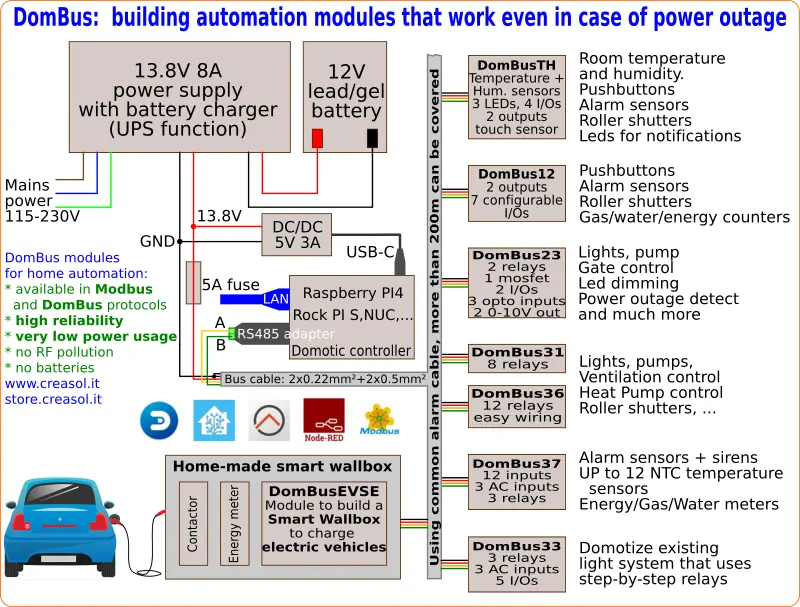
Store website - Information website
For our products we can offer FULL SUPPORT and CUSTOMIZATION: please contact us by Email or Telegram
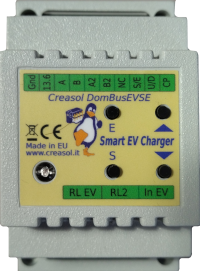 Complete solution to make a Smart EVSE, charging the electric vehicle using only energy from renewable source (photovoltaic, wind, ...), or adding 25-50-75-100% of available power from the grid.
Complete solution to make a Smart EVSE, charging the electric vehicle using only energy from renewable source (photovoltaic, wind, ...), or adding 25-50-75-100% of available power from the grid.
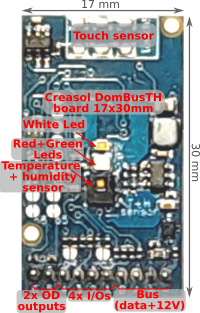 Compact board, 32x17mm, to be installed on blank cover with a 4mm hole in the middle, to exchange air for the relative humidity sensor. It can be installed in every room to monitor temperature and humidity, check alarm sensors, control blind motor UP/DOWN, send notifications (using red and green leds) and activate white led in case of power outage.
Compact board, 32x17mm, to be installed on blank cover with a 4mm hole in the middle, to exchange air for the relative humidity sensor. It can be installed in every room to monitor temperature and humidity, check alarm sensors, control blind motor UP/DOWN, send notifications (using red and green leds) and activate white led in case of power outage.
Includes:
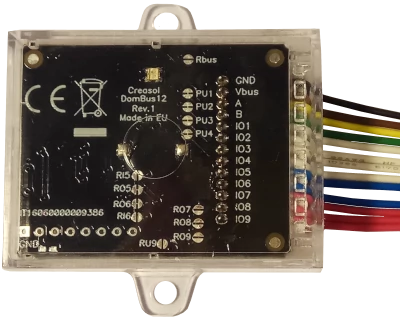 Very compact, versatile and cost-effective module with 9 ports. Each port can be configured by software as:
Very compact, versatile and cost-effective module with 9 ports. Each port can be configured by software as:
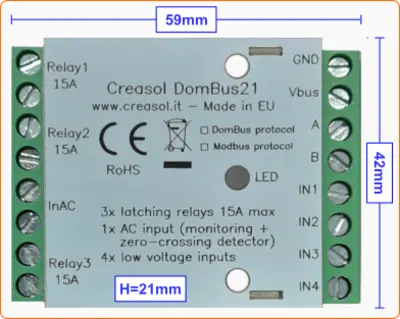 Very low power consumption module designed to enable up to 3 high power loads, up to 15A (3kW).
Very low power consumption module designed to enable up to 3 high power loads, up to 15A (3kW).
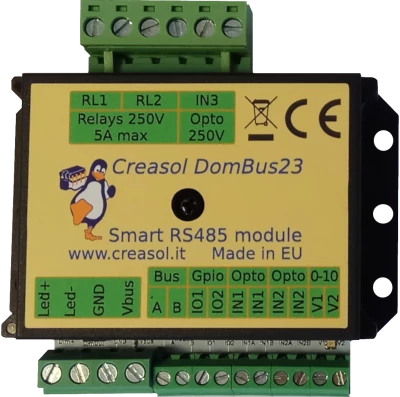 Versatile module designed to control gate or garage door.
Versatile module designed to control gate or garage door.
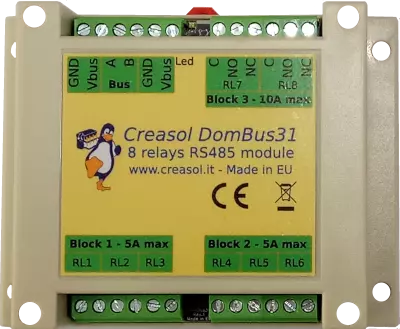 DIN rail low profile module, with 8 relays and very low power consumption:
DIN rail low profile module, with 8 relays and very low power consumption:
 Versatile module with 230V inputs and outputs, and 5 low voltage I/Os.
Versatile module with 230V inputs and outputs, and 5 low voltage I/Os.
 Module designed to control 3 lights already existing and actually controlled by 230V pushbuttons and step-by-step relays. In this way each light can be activated by existing pushbuttons, and by the domotic controller.
Module designed to control 3 lights already existing and actually controlled by 230V pushbuttons and step-by-step relays. In this way each light can be activated by existing pushbuttons, and by the domotic controller.
Each relay can toggle the existing step-relay, switching the light On/Off. The optoisolator monitors the light status. The 5 I/Os can be connected to pushbuttons to activate or deactivate one or all lights.
 DIN rail module, low profile, with 12 relays outputs and very low power consumption.
DIN rail module, low profile, with 12 relays outputs and very low power consumption.
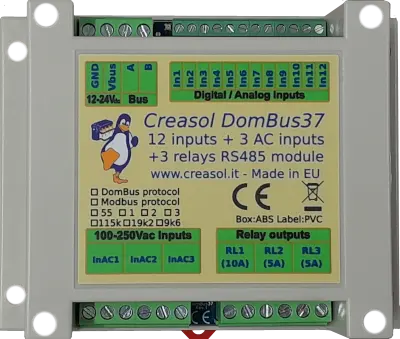 Module designed to be connected to alarm sensors (magnetc contact sensors, PIRs, tampers): it's able to monitor mains power supply (power outage / blackout) and also have 3 relays outputs.
Module designed to be connected to alarm sensors (magnetc contact sensors, PIRs, tampers): it's able to monitor mains power supply (power outage / blackout) and also have 3 relays outputs.
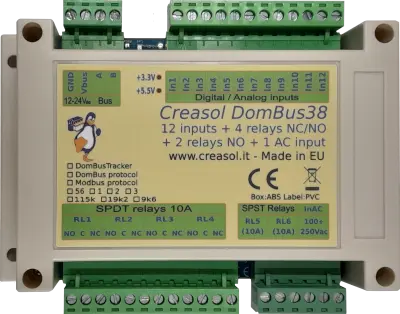 DIN rail module designed for burglar alarm system.
DIN rail module designed for burglar alarm system.
![]() DIN rail module that control azimuth + elevation/tilt motors of a sun tracker, to maximize photovoltaic energy production during the day and seasons.
DIN rail module that control azimuth + elevation/tilt motors of a sun tracker, to maximize photovoltaic energy production during the day and seasons.
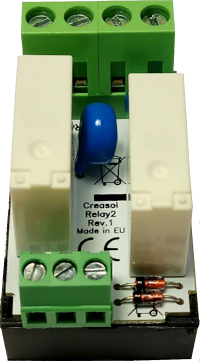 Simple module with 2 relays, to be used with DomBus modules or other electronic boards with open-collector or open-drain outputs
Simple module with 2 relays, to be used with DomBus modules or other electronic boards with open-collector or open-drain outputs
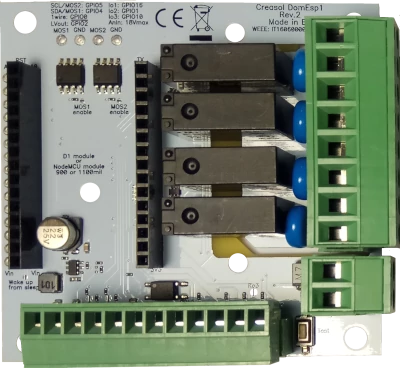 IoT board designed for NodeMCU v3 board using ESP8266 WiFi microcontroller
IoT board designed for NodeMCU v3 board using ESP8266 WiFi microcontroller